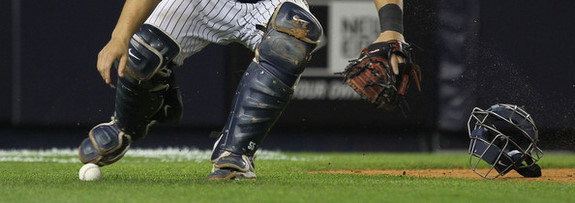
Catcher defense is incredibly hard to quantify, but there’s been a lot of research done on the subject and a lot of progress made in recent years. Back in October, Bojan Koprivica published a ridiculously in-depth analysis on blocking pitches using PitchFX data, determining just who the best catchers were at keeping the ball in front of them. It’s an intense research piece but a surprisingly easy read, so I highly recommend checking it out. Even if you read it back in October, it’s worth re-reading for a refresher.
Since the start of the 2009 season, Yadier Molina has saved a total of 16.0 runs by blocking pitches, the most in baseball. That’s not a surprise since he’s generally regarded as the best defensive catcher in the game. Brian McCann (14.2) and Matt Wieters (13.3) round out the top three. Based on Koprivica’s work, pitch blocking is similar to base running in that its impact isn’t as significant as we may think. The best pitch blockers save about seven runs per season while the worst allow seven runs. Most catchers are within two runs of average. Yeah, every bit does count, but on the whole it’s not a huge part of the game.
FanGraphs now carries pitch blocking data using Koprivica’s algorithm, so it’s nice and easy for us to dig up the stats. Here’s how the Yankees’ two primary catchers have fared at blocking pitches over the last three seasons…
| Expected Passed Pitches, CPP |
Actual Passed Pitches, APP |
Runs Saved, RPP | RPP MLB Rank | |
|---|---|---|---|---|
| Frankie Cervelli | 59 | 59 | 0.0 | 27th |
| Russell Martin | 142 | 159 | -6.5 | 51st |
I used a minimum of 1,000 innings caught over the last three seasons, giving us 58 qualifiers. Cervelli has performed exactly as expected during that time, which is pretty neat. Martin has been much worse however, which goes against pretty much everything we know and have heard about him defensively. It’s only 6.5 runs across 3036.2 innings, but only seven qualified catchers have been worse at blocking balls in the dirt than he has over the last three years*.
* One of those seven is Jorge Posada at -8.2 RPP in 1,469.1 innings (54th out of 58 qualifiers). Former Yankee Jose Molina isn’t much better believe it or not, he’s at -7.2 RPP in 1,200.1 innings.
Breaking it down by the individual seasons, we can see that most of the damage came back in 2009. Russ was expected to allow 48 balls to get by him based on what his pitchers threw that year, but he actually allowed 69 passed pitches. Those 21 extra passed pitches resulted in a -5.8 RPP for the season, the worst in baseball. Martin was pretty much league average in both 2010 (-0.1 RPP) and 2011 (-0.6 RPP) when it came to blocking balls, and the improvement since 2009 can probably be attributed to a million different things. I guess he seemed so much better than average last year because we were stuck watching Posada all those years.
Like I said earlier, passed pitches typically have a very small impact in the grand scheme of things, just a handful of runs each year. It seems a lot more when you’re watching a game and a passed ball allows the tying run to move into scoring position in the late innings, but that stuff evens out over the course of a 162-game schedule. Martin’s real defensive value comes from his ability to frame pitches according to the various catcher defense studies, but over the last two years he hasn’t killed his team with his pitch blocking skills either.
Leave a Reply
You must be logged in to post a comment.